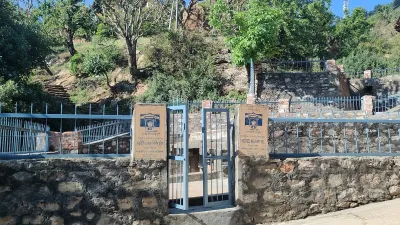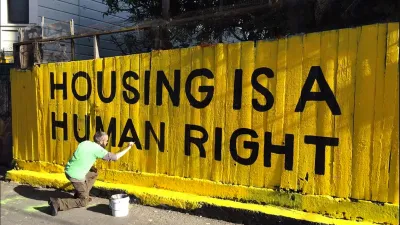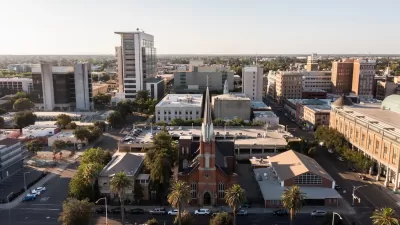Last week I attended the Society of American City and Regional Planning History (SACRPH) conference in Portland, Maine. The conference attracted a variety of notable planners and historians to my hometown for sessions on everything from radical 1970s public participation exercises to best practices in waterfront planning. At the conference, outgoing group president and historian Greg Hise gave a provocative lecture titled “Whither the Region, or Why Ought There to Be an ‘R’ in SACRPH?” In the talk he described how he believed there was a declining interest in the organization in studying regions, pointing out that the word was declining in use in the titles of papers presented at recent conferences.
Last week I attended the Society of American City and Regional Planning History (SACRPH) conference in Portland, Maine. The conference attracted a variety of notable planners and historians to my hometown for sessions on everything from radical 1970s public participation exercises to best practices in waterfront planning.
At the conference, outgoing group president and historian Greg Hise gave a provocative lecture titled "Whither the Region, or Why Ought There to Be an ‘R' in SACRPH?" In the talk he described how he believed there was a declining interest in the organization in studying regions, pointing out that the word was declining in use in the titles of papers presented at recent conferences.
His remarks spurred some interesting conversation from the attendees. Some suggested regional studies were still taking place, just under different names. Others pointed out there is not much true regional planning taking place in the U.S., and therefore studies of planning tend to focus the scale that planning actually takes place: state, city, or neighborhood. Greg rightfully responded that historians should not simply accept the categories created by planners. If the region is still a meaningful economic, social, or political entity (on which most seemed to agree) then historians should study regions.
I partly agree with those who thought the region is alive and well, just under a new name. The U.S. population is highly urbanized, with some 80% living in metropolitan areas, more than at any point in our past. Not only are more people living in cities, these metropolitan areas have often ballooned to unprecedented size. For example, the Washington Board of Trade uses the terms regional and metropolitan nearly interchangeably and uses a regional map that extends nearly fifty miles from downtown Washington. How would this map compare with a map of the mid-Atlantic region? Clearly the previously clear distinction between cities and regions is becoming less meaningful as our cities have increased in population and size.
Nonetheless, I thought I'd post here some of my reactions to Greg's talk and the subsequent discussion. I think the issue is important beyond the scope of one academic organization.
Although there may be a limited amount of regional decision-making in the U.S., there's a significant amount of regional study and some planning taking place within a variety of types of organizations. These groups range from regional planning agencies, councils of governments, public infrastructure agencies like regional transit or utility providers, and business organizations. Cursory web searching turns up a large number of public regional planning organizations, and a sample will convey their diversity: Southeast Wisconsin Regional Planning Commission, South Florida Regional Planning Council, Tahoe Regional Planning Agency, and the West Michigan Regional Planning Commission. In addition, chamber of commerce organizations, boards of trades, and other private organizations are also generally metropolitan or regional in scope.
There are so many such organizations they even have their own lobby in Washington, the National Council of Regional Councils, of which both regional and metropolitan organizations can be members. These organizations seem to vary according to state level policies. Florida, Texas, and Wisconsin, for example seem to have an unusual number of these groups. While the amount of actual authority they have can range widely, these organizations have an institutionalized role in large scale planning, particularly related to transportation and air quality.
If we concede there exists regional study, coordination, and some planning, there are a few pragmatic reasons for the limited number of studies at a regional scope.
First, the ideas of early planning advocates interested in regions have waned as the profession has matured. A source of ideas for Lewis Mumford and the influential New York Regional Plan Association was Patrick Geddes, a thinker who has all but been forgotten by younger planners. Any history of regional planning will mention Geddes, who thought of cities as embedded in a larger regional context. Although the profession has gained a much richer urban understanding in the ensuing years, along the way early planners' insistence on a regional scope has been diluted.
Second, the writing of history reflects the way information is recorded. Archives are maintained at the city and state levels, but generally not at the regional level. Big city archives and newspapers provide logical starting points for urban research, but neglect suburban growth and development. The documents necessary for a true regional analysis are spread among multiple small newspapers, various political jurisdictions, and private organizations.
Lastly, from the point of view of professional history, I think another trend also partly explains the dearth of interest in the region. For nearly a generation after they began to decline in significance, intellectuals of all stripes continued to study the central city to the exclusion to attention to the burgeoning suburbs. A series of suburban studies have brought a new metropolitan scope to history, with such works as Sam Bass Warner's Streetcar Suburbs (1962), Kenneth Jackson's Crabgrass Frontier (1985), Joel Garreau's Edge Cities (1992), being some early innovators, and today the field has expanded so much we can now discuss the "new suburban history." In a sense, this work was a necessary antecedent to robust studies of a metropolitan or regional scope. Some recent work, like Hise's own Magnetic Los Angeles (1997) and Zach Schrag's Great Society Subway (2006), begins to synthesize urban and suburban history to present history at the scale of the metropolitan region.
What do you think: are regional distinctions still important? Why do we hear so little about them? Should we plan for regions even if planning authority is splintered among jurisdictions?

Alabama: Trump Terminates Settlements for Black Communities Harmed By Raw Sewage
Trump deemed the landmark civil rights agreement “illegal DEI and environmental justice policy.”

Planetizen Federal Action Tracker
A weekly monitor of how Trump’s orders and actions are impacting planners and planning in America.

The 120 Year Old Tiny Home Villages That Sheltered San Francisco’s Earthquake Refugees
More than a century ago, San Francisco mobilized to house thousands of residents displaced by the 1906 earthquake. Could their strategy offer a model for the present?

LA’s Tree Emergency Goes Beyond Vandalism
After a vandal destroyed dozens of downtown LA trees, Mayor Karen Bass vowed to replace them. Days later, she slashed the city’s tree budget.

Sacramento Leads Nation With Bus-Mounted Bike Lane Enforcement Cameras
The city is the first to use its bus-mounted traffic enforcement system to cite drivers who park or drive in bike lanes.

Seattle Voters Approve Social Housing Referendum
Voters approved a corporate tax to fund the city’s housing authority despite an opposition campaign funded by Amazon and Microsoft.
Urban Design for Planners 1: Software Tools
This six-course series explores essential urban design concepts using open source software and equips planners with the tools they need to participate fully in the urban design process.
Planning for Universal Design
Learn the tools for implementing Universal Design in planning regulations.
Ada County Highway District
Clanton & Associates, Inc.
Jessamine County Fiscal Court
Institute for Housing and Urban Development Studies (IHS)
City of Grandview
Harvard GSD Executive Education
Toledo-Lucas County Plan Commissions
Salt Lake City
NYU Wagner Graduate School of Public Service






























